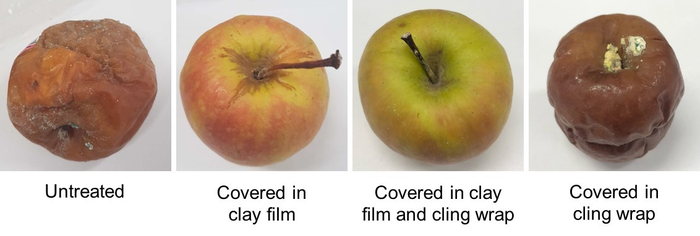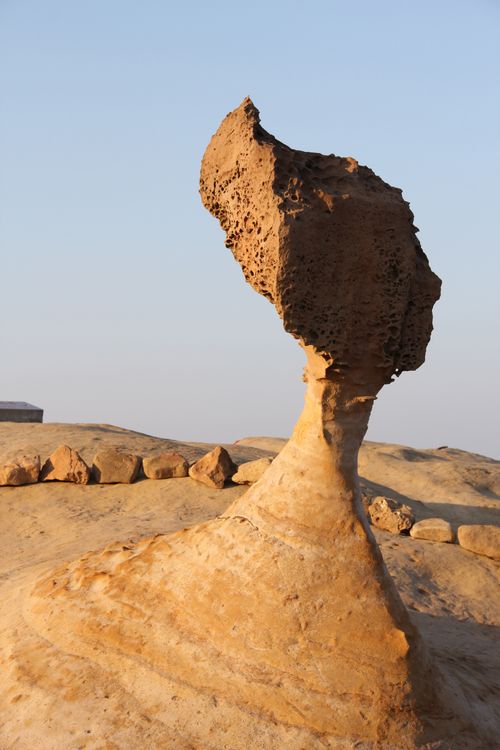Which apple would you like to eat?

This research into food packaging comes from Japan’s National Institute for Materials in a March 8, 2022 press release (also on EurekAlert but published on April 12, 2022),
An international research team consisting of NIMS, The University of Queensland and National Taiwan University has succeeded in creating a clay film with its gas permeability optimized for long-term storage of fresh produce by adjusting the sizes of the clay nanosheet particles comprising it. The team then uniformly coated the surfaces of various fruits with the film. This treatment kept the fruits’ respiration rates low without completely depriving them of oxygen, preventing them from decaying.
Efforts have been made to develop gas barrier films using clay nanosheets. Although some researchers attempted to improve the film properties of clay nanosheets by adding organic polymers to them, films can also be formed using only clay nanosheets without additives. Only a few studies had previously evaluated the physical properties of clay films composed solely of clay nanosheets.
This international joint research team focused on the gas permeability of clay films and found that a film composed of clay nanosheets with particle sizes in the range of several dozen nanometers (1 nm = one millionth of 1 mm) had relatively high permeability to gas molecules as they can pass through gaps between particles. This gas permeability is equivalent to that of plastic bags with minute pores used to store fresh produce. These bags are able to adequately reduce oxygen supply to fresh fruit, preventing it from ripening too rapidly. The gas permeability similarities between the clay film and the plastic bags inspired the research team to assess the ability of the clay film to preserve the quality of fresh produce for long periods of time.
In this research, the team applied a suspension of clay nanosheets to the surfaces of various fruits (e.g., apples, bananas and oranges) to form uniform films on their surfaces. The team also prepared untreated fruits and fruits covered in cling wrap for comparison. The gas emissions and appearance of these treated and untreated fruits were monitored for several months. As shown in the figure [above], the untreated apples (the first photo from the left) had decayed by the end of the experimental period and the apples covered only in cling wrap (the fourth photo from the left) had also decayed and grown mold. By contrast, the apples coated with the clay film (the two middle photos) did not decay or grew mold, presumably because the film reduced the external oxygen supply needed for ripening and mold growth. In addition, the clay film was confirmed to be in tight contact with the surfaces of the apples it coated, suggesting that it may be able to effectively block the diffusion of ethylene into the air, a phytohormone which plays an important role in inducing fruit ripening.
In addition to its potential ability to restrict the external oxygen supply and ethylene diffusion, the clay film may be able to prevent odor compounds produced by fresh produce from diffusing into the air, possibly making them less attractive to pests. In future research, the team plans to improve the ease of application and strength of the clay film to make it more suitable for preserving the quality of fresh produce during its transportation to the market.
This project was carried out by an international joint research team consisting of Miharu Eguchi (Senior Researcher, Mesoscale Materials Chemistry Group, International Center for Materials Nanoarchitectonics, NIMS) and researchers from The University of Queensland and National Taiwan University. This work was supported in part by JST-ERATO Yamauchi Materials Space-Tectonics Project.
Here’s a link to and a citation for the paper,
Highly adhesive and disposable inorganic barrier films: made from 2D silicate nanosheets and water by Miharu Eguchi, Muxina Konarova, Nagy L. Torad, Te-An Chang, Dun-Yen Kang, Joe Shapter and Yusuke Yamauchi. J. Mater. Chem. A, 2022,10, 1956-1964 DOI: https://doi.org/10.1039/D1TA08837H First published 02 Dec 2021 Print version published January 28, 2022
This paper is behind a paywall.
